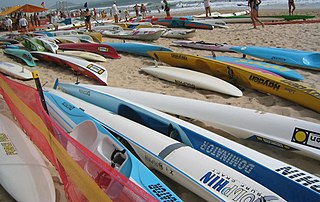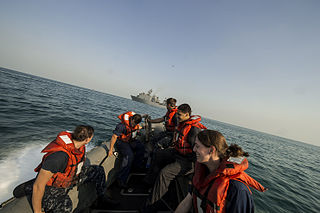Related Research Articles

Swimming is the self-propulsion of a person through water, or a liquid substance, usually for recreation, sport, exercise, or survival. Locomotion is achieved through coordinated movement of the limbs and the body. Humans can hold their breath underwater and undertake rudimentary locomotive swimming within weeks of birth, as a survival response.

Surf lifesaving is a multifaceted movement that comprises key aspects of voluntary lifeguard services and competitive surf sport. Originating in early 20th century Australia, the movement has expanded globally to other countries including New Zealand, Ireland, South Africa, the United Kingdom. Surf lifesavers in Australia are colloquially known as "Clubbies".

Drowning is a type of suffocation induced by the submersion or immersion of the mouth and nose in a liquid. Most instances of fatal drowning occur alone or in situations where others present are either unaware of the victim's situation or unable to offer assistance. After successful resuscitation, drowning victims may experience breathing problems, vomiting, confusion, or unconsciousness. Occasionally, victims may not begin experiencing these symptoms for several hours after they are rescued. An incident of drowning can also cause further complications for victims due to low body temperature, aspiration of vomit, or acute respiratory distress syndrome.

A lifeguard is a rescuer who supervises the safety and rescue of swimmers, surfers, and other water sports participants such as in a swimming pool, water park, beach, spa, river and lake. Lifeguards are trained in swimming and CPR/AED first aid, certified in water rescue using a variety of aids and equipment depending on requirements of their particular venue. In some areas, lifeguards are part of the emergency services system to incidents and in some communities, lifeguards may function as the primary EMS provider.

The Canadian Red Cross Society is a Canadian humanitarian charitable organization, and one of 192 national Red Cross and Red Crescent societies. The organization receives funding from both private donations and from Canadian government departments.

A personal flotation device is a flotation device in the form of a vest or suite that is donned and fastened to a user to prevent the wearer from drowning in a body of water. The device will keep the wearer afloat with his/her head and mouth above the surface – he/she does not have to swim or tread water in order to stay afloat and can even be unconscious.

Toronto Parks, Forestry and Recreation (PFR) is the division of Toronto's municipal government responsible for maintaining the municipal park system and natural spaces, regulation of and provision of urban forestry services, and the delivery of recreational programming in city-operated facilities.

Surf Life Saving New Zealand (SLSNZ) is the national association representing 74 Surf Life Saving Clubs in New Zealand. The organisation's motto is 'In it for Life'. This refers to both the long relationship many members have with the organisation, as well as to the organisation's purpose of preventing drowning and injury, thereby saving lives.

Swimming lessons are the process of learning to swim. In most countries there is a definition of a number of swimming levels that are reached in the process of the curriculum. The respective certificates of swimming tests are required for further training in aquatic abilities. Many countries have defined a minimum swimming level that children should reach by the end of primary education, in most cases with the help of school swimming classes being part of the normal curriculum.

The Royal Life Saving Society Canada, commonly known as the Lifesaving Society, is a Canadian registered charity that works to prevent water-related injuries through various programs across Canada. The Lifesaving Society is an independent organization that is composed of ten provincial/territorial branches, tens of thousands of individual members, and over 4,000 affiliated swimming pools, waterfronts, schools and clubs. The Society helps prevent drowning and aquatic injury through its training programs, public education, drowning-prevention research, safety management and overseeing the sport of lifesaving.

Surf Life Saving Australia (SLSA) is an Australian not-for-profit community organisation that promotes water safety and provides surf rescue services.

Lifesaving is the act involving rescue, resuscitation and first aid. It often refers to water safety and aquatic rescue; however, it could include ice rescue, flood and river rescue, swimming pool rescue and other emergency medical services. Lifesaving also refers to sport where lifesavers compete based on skills, speed and teamwork. Lifesaving activities specialized in oceanic environment is called surf lifesaving or coastal lifesaving.

Society for the Protection of Nature in Israel, or SPNI, is an Israeli non-profit environmental organization working to preserve plants, animals, and natural environments that represent bio-diversity, by protecting the lands and waters needed for their survival, and is Israel's oldest and largest conservation organization.

Life Saving Victoria is an Australian life saving organisation formed in 2002 from a merger of the Victorian Branch of the Royal Life Saving Society Australia and Surf Life Saving Victoria. Life Saving Victoria works to prevent drownings and other water related deaths and injuries in Victoria. Life Saving Victoria teaches local communities in Victoria about water safety, swimming and resuscitation. It also provides surf life saving services and patrols for beaches across the state. Life Saving Victoria is an emergency support agency to Victoria Police for water based emergencies.
Water safety refers to the procedures, precautions and policies associated with safety in, on, and around bodies of water, where there is a risk of injury or drowning. It has applications in several occupations, sports and recreational activities.
The Center to Prevent Youth Violence (CPYV), originally known as PAX, is a non-profit organization co-founded in 1998 by Daniel Gross and Talmage Cooley, with the mission of ending the crisis of gun violence in America by repositioning the issue as a common sense matter of public health and safety, rather than the seemingly intractable political wedge issue it had become. By 2002, PAX had become the largest non-lobbying organization working on gun violence prevention as a result of the success and rapid expansion of its ASK and SPEAK UP campaigns, which were designed to have immediate impact on the frequency of gun deaths and injuries, while also shifting the national dialogue around guns to a prevention-driven, public health and safety orientation.
Lifeguards Without Borders is an international non-profit organization of volunteer lifeguards and health care professionals who promote training, program development, and research.
Gordon Grant Giesbrecht is a Canadian physiologist who operates the Laboratory for Exercise and Environmental Medicine at the University of Manitoba in Manitoba, Canada. He studies the effects of extreme environments, including cold, heat, hypoxia, and hypobaria on the human body. His laboratory motto is vitas salvantas. He was dubbed "Professor Popsicle" in a feature article in Outside Magazine.
The International Surf Lifesaving Association (ISLA) is a nonprofit organization that advances professional lifesaving development to areas in need around the globe. ISLA uses latest technology to identify areas in need. ISLA advances development through lifeguard training programs and aquatic rescue operation consults, lifeguard exchanges, equipment donations, and by integrating with drowning prevention organizations to share information, techniques, stories, and culture.

A playground, playpark, or play area is a place designed to provide an environment for children that facilitates play, typically outdoors. While a playground is usually designed for children, some are designed for other age groups, or people with disabilities. A playground might exclude children below a certain age.
References
- ↑ "Keeping Communities Safe," Archived January 15, 2013, at archive.today as published in a press release by The Canadian Red Cross, July 2012
- ↑ "Take part in the Open Water Wisdom Campaign," Archived 2012-08-01 at the Wayback Machine as published in The Nunavut Echo, July 2012
- ↑ "Dangerous Waters," by Michelle Zilio as published in the Ottawa Citizen, August 2012
- ↑ "Federal government announces funding to prevent sport, recreation injuries," as published in the Ottawa Citizen, December 2012
- ↑ "OPEN WATER WISDOM CAMPAIGN RELEASES NEW RADIO PUBLIC SERVICE ANNOUNCEMENT ON RESPECTING THE POWER OF NATURE," by Open Water Wisdom, October 2012
- ↑ "NEW RADIO PUBLIC SERVICE ANNOUNCEMENT ON IMPORTANCE OF OPEN WATER SAFETY IN SPORTS AND RECREATION," by Open Water Wisdom, October 2012
- ↑ "OPEN WATER WISDOM CAMPAIGN RELEASES NEW RADIO PUBLIC SERVICE ANNOUNCEMENT ON LIFEJACKET USE THIS FALL," by Open Water Wisdom, October 2012
- ↑ "OPEN WATER WISDOM CAMPAIGN RELEASES NEW RADIO PUBLIC SERVICE ANNOUNCEMENT ON COLD WATER," by Open Water Wisdom, November 2012
- ↑ "About Open Water Wisdom," as posted by Open Water Wisdom